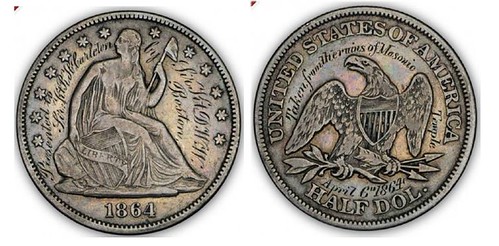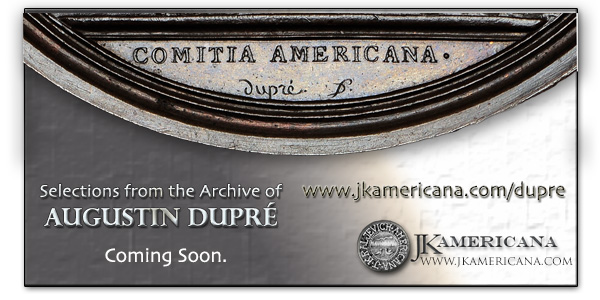
PREV ARTICLE
NEXT ARTICLE
FULL ISSUE
PREV FULL ISSUE
1864 MASONIC ENGRAVED HALF DOLLAR
The June 2014 issue of the Liberty Seated Collectors Club’s electronic newsletter, The E-Gobrecht has a lot of great articles. With permission, here is Len Augsburger's article about an interesting 1864 Masonic Engraved Half Dollar.
-Editor
Coins are boring. I mean the coins you’ve seen a million times that aren’t interesting anymore. Turn them all into eBay junk lots, because this month we have something much more interesting to consider. I’m sure quite a few of us are constantly surfing the Internet checking out the latest dealer listings, and once in a great awhile you find something which grabs the attention - like this offering from John Kraljevich Americana:

What we have here is an 1864 half dollar. It is nicely toned, and the surfaces appear to be relatively mark free – aside from the engraving, which has quite a tale to tell. The story starts with the reverse, which is inscribed “Taken from the ruins of Masonic Temple / April 6th 1864.” This refers to the fire which destroyed the Boston Masonic Temple in 1864. Masonry was quite the thing in the early days of our country, more popular than now, and these cathedral-like buildings popped up in the large cities. If you’ve walked around downtown Philadelphia, you’ll get an idea – that Masonic temple, at Penn Square, remains in its original glory. In Boston, there was nothing left to do but rebuild, and a new temple was raised several years later. But relics were taken from the charred remains in 1864, including ceremonial silver implements which were delivered to the Mint in Philadelphia to be coined into half dollars. (An intrepid researcher is currently searching for the deposit record in the Mint Archives, and we eagerly await his results.) This coin thus falls into the category of relic coin, a situation where the source of the bullion for a particular coin is well-known. There are other examples in the American series, such as the 1848 CAL. GOLD quarter eagles (coined from the first gold shipment from California to the US Mint), or the 1794 silver dollars, for which the bullion was deposited by the Mint Director David Rittenhouse. Then there is the mythology of George Washington supplying the bullion for the 1792 half dismes, for which some, but not definitive, evidence exists. Do you sense a theme – all these coins are really expensive! The current coin is somewhat less pricey, but not cheap. Mr. Kraljevich always does his best to separate me from my money, and I am trying to hold out, but this coin is making it very hard. Relic coins represent something more than just a coin – what we have here is a high degree of historicity, and if the dealer happens to have academic training as a historian, the asking price will be set accordingly. Gregory Brunk, in his reference on counterstamped coins, argued that this coin is correctly called a commemorative coin. After thinking about this, it occurred to me that the coin collector’s lexicon is not always so precise. What exactly is a proof coin? Some of the Liberty Seated issues are deceptive – proof dies were used for circulation strikes. If the coiner ran off a few hundred coins and set them aside as proofs, how are those coins any different from the very next coin that came off the die? This extends to other situations – few of us considered the precise definition of a “vote” until the 2000 Presidential election. We now even wonder about death – if a person has no brain activity, are they dead? Now that I’ve introduced religion and politics into the equation, let’s get back to coins. What makes a commemorative coin? They are “one-off” issues typically tied to a specific historical event – clearly we have that here. Of course, we don’t have the legislation that accompanies commemorative issues , which is the strongest argument against commemorative status in this case. There are about dozen known examples of these “Masonic” half dollars, one of which is in the Massachusetts Historical Society and was exhibited during the 2010 Boston ANA. That piece is similarly engraved on the reverse, and the obverse is engraved “Wm. Hurd Boston Encampment.” Hurd was a member of the Boston Masons, and the present piece in the Kraljevich inventory is similarly engraved to a member of the Boston group: "Presented to Sir KT R H Carleton / by / Sir KT D.W.W. / Boston." Kraljevich notes that “KT is an abbreviation for Knights Templar. RH Carleton appears to be Robert H. Carlton, who marched in the 1868 procession to mark the opening of the new Masonic Temple in Boston….” The identity of D.W.W. is unclear, but it seems quite likely he was a lodge brother of Carleton. Among Liberty Seated coinage, this one is unique – in no other case can we tie specific bullion to specific coins. Combined with the rarity of the emission (the exact mintage may eventually be discovered in the Mint records – perhaps 30 pieces?), and the overall choice condition of this particular specimen, there is a lot to like here. For more information on the Liberty Seated Collectors Club, see: www.lsccweb.org

Wayne Homren, Editor The Numismatic Bibliomania Society is a non-profit organization promoting numismatic literature. See our web site at coinbooks.org. To submit items for publication in The E-Sylum, write to the Editor at this address: whomren@gmail.com To subscribe go to: https://my.binhost.com/lists/listinfo/esylum All Rights Reserved. NBS Home Page Contact the NBS webmaster 
|